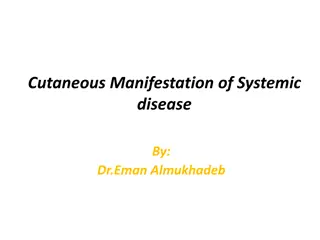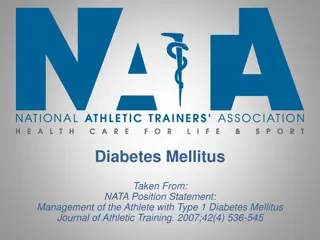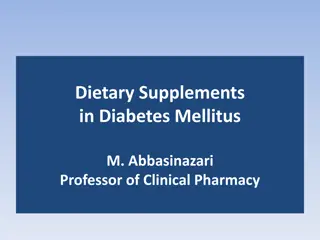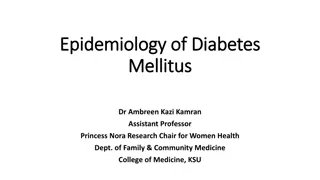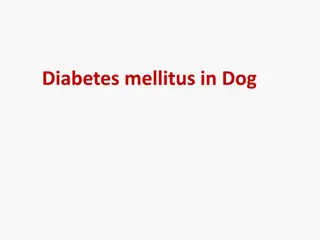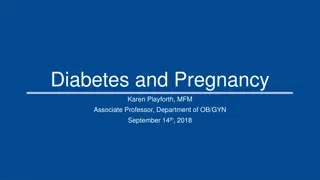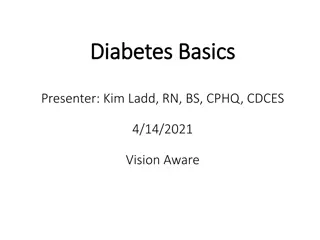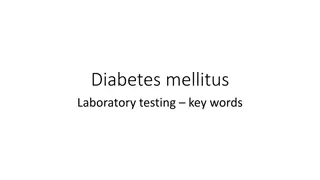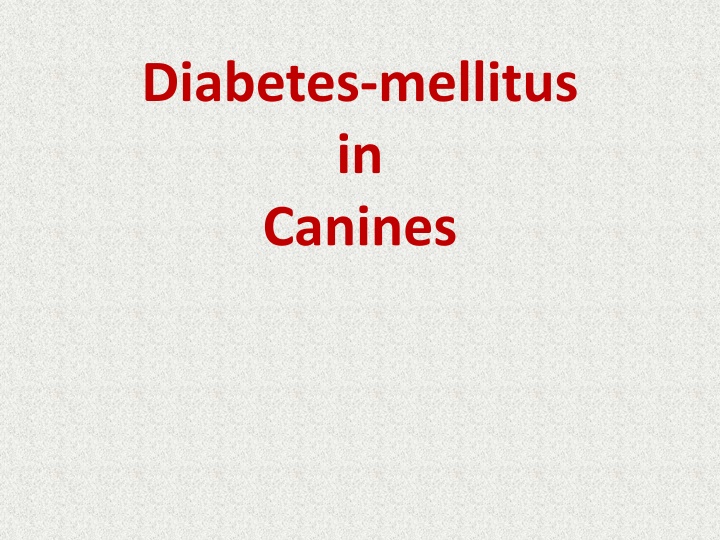
Diabetes Mellitus in Canines: Causes, Symptoms & Treatment
Learn about diabetes mellitus in canines, a disorder affecting carbohydrate metabolism due to insulin insufficiency. Explore its causes, symptoms like polyuria and polydipsia, and progression to ketoacidotic coma. Discover the incidence, pathogenesis, and clinical signs associated with this condition in dogs.
Download Presentation

Please find below an Image/Link to download the presentation.
The content on the website is provided AS IS for your information and personal use only. It may not be sold, licensed, or shared on other websites without obtaining consent from the author. If you encounter any issues during the download, it is possible that the publisher has removed the file from their server.
You are allowed to download the files provided on this website for personal or commercial use, subject to the condition that they are used lawfully. All files are the property of their respective owners.
The content on the website is provided AS IS for your information and personal use only. It may not be sold, licensed, or shared on other websites without obtaining consent from the author.
E N D
Presentation Transcript
Diabetes-mellitus in Canines
Etiology: Diabetes mellitus (hypoinsulinism) is a complex disorder of carbohydrate, metabolism Which results from an inability to produce or utilize adequate amounts of insulin Most cases of diabetes mellitus in canines are associated with the destruction of the cells, particularly following pancreatitis or with an idiopathic reduction in the number of cells and even the disappearance of many of the islets fat, and protein
Incidence: Diabetes mellitus is 3 times as common in bitches as in males and its onset often follows oestrus It appears more frequently in obese animals It is also more common in dogs over 8 years old and in certain Dachshund breeds especially
Pathogenesis and clinical signs: Polyuria and polydipsia are prime clinical signs The renal threshold for glucose in dog lies between 175-220 mg/100 ml Usually when blood glucose level exceeds 180 mg/100 ml, glucose is not completely reabsorbed from the renal tubules resulting in glycosuria and, because of osmotic diuresis, production and frequency of micturition (polyuria) Additional water is consumed to compensate for this loss (polydipsia) increased urine
Polyphagia is often present, but not invariably, until the ketotic stage is reached Other common clinical signs are cataract (usually bilateral) in 10-40% cases, an enlarged liver in upto 50% dogs, and muscle wasting which produces weight loss Neuropathy in canine diabetes mellitus is rarely recorded In the terminal (ketoacidotic) stage, fat breakdown is increased, and because fatty acids are produced faster than they can be oxidised, acetoacetic acid is formed and then converted to acetone or beta hydroxybutyric acid These 3 ketone bodies are excreted in the urine and acetone is also exhaled in the breath
The above 3 acids produce metabolic acidosis and acetoacetic acid and acetone are directly toxic to the CNS In this stage clinical signs like inappetance, increased rate and vomiting, dehydration and listlessness progress to ketoacidotic (diabetic ketotic) coma and ultimately death Animals which are markedly acidotic, depressed and dehydrated when presented are most likely to have very poor prognosis There may be pain due to pancreatitis which is the most common complication of ketoacidosis in dogs vomiting more than two or three times per 48 hrs. Severe dehydration may lead to the onset of acute renal failure depth of breathing,
Diagnosis: It is based chiefly on: 1) 2) Clinical signs Findings of glycosuria and hyperglycemia Glucose is usually absent from canine urine and its presence is mainly associated with diabetes mellitus. In 75% of newly diagnosed cases the glucose level is above 2% A fasting blood glucose level above 130 mg/100 ml (normal range 60-100 mg/ml) is most commonly due to diabetes mellitus Ketone bodies are often present in diabetes mellitus and can be detected by Rothera s test Specific gravity of urine may be raised though often not sufficiently to put it above the normal range Glucose tolerance test (GTT) is valuable in doubtful cases of DM 3) 4) 5)
Treatment: 1) In mild diabetes mellitus the reduction of carbohydrate intake, (and it obese, fat intake also) is often sufficient to control hyperglycemia and glycosuria Moderate cases may need in addition an oral hypoglycaemic drug to stimulate insulin secretion. The most commonly employed are sulphonylureas and among them chlorpropamide Unfortunately, most diagnosed cases in the dog are severe (with ketonuria) and the above therapy will not control the disease Successful treatment in such cases requires routine (daily) subcutaneous injection of insulin after urine testing For this, stabilisation (assessing and regulating the animal s insulin requirements) is done. Stabilisation and maintenance can be done using a depot insulin with 24 hr action, e.g. (a)Lente Insulin, a mixture of insulin zinc suspensions (b)Isophane Insulin (Neutral Protamine Hagedorn-NPH) with action that lasts slightly less than 24 hrs. (c)Protomine Zinc Insulin (PZI) whose action lasts for slightly longer than 24 hrs. 2) 3)
Soluble insulin with a rapid, short acting effect is best for the emergency treatment of ketoacidotic coma For commencing insulin treatment, it is valuable to know exact glucose concentration and for this urine sample, collected first thing in the morning, are tested by Benedict s quantitative test As a general guide the number of units in the first s/c injection should be twice the percentage of glucose concentration, i.e. if the glucose concentration is 4%, 8 units should be given Subsequent daily injections are regulated according to that morning s urinary glucose level (on the basis of quantitative Benedict s test) and the following rules: (a) Urinary glucose = 1% or more: give previous day s dose plus 2 units (b) Urinary glucose = 0.1 0.5%: give previous day s dose
(c) Urinary glucose = 0%: give previous day s dose minus 2 units (d) If hypoglycemic signs or coma occurred on previous day: give previous day s dose minus 4 or more units Stabilisation on a more or less constant dose may take 3-4 weeks and then the same regimen may be followed A single daily injection of insulin should be given in the mid morning after providing the dog with quarter of the daily food If dog does not eat then don t inject. Remainder food should be given after 8-9 hrs. when insulin has maximum effect
4) Dietary control and exercise are important. Diet should be low in fat (80% meat + 20% carbohydrate) fed @ 1 oz/kg body wt. per day (5) Regular weighing and titbits must not be given (6) Ad lib provision of water should be made. Reduced consumption of water indicates successful therapy


